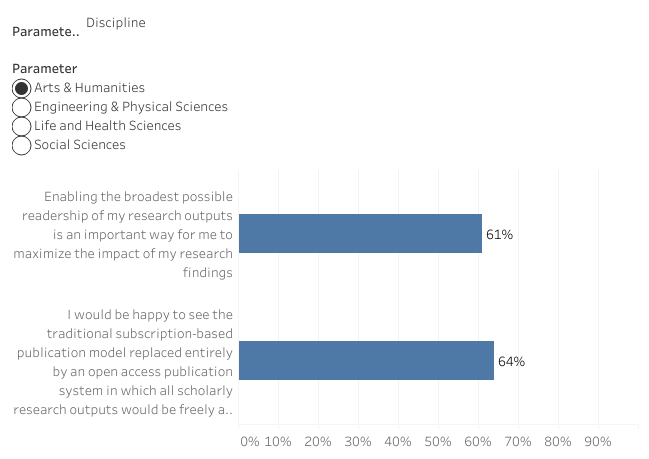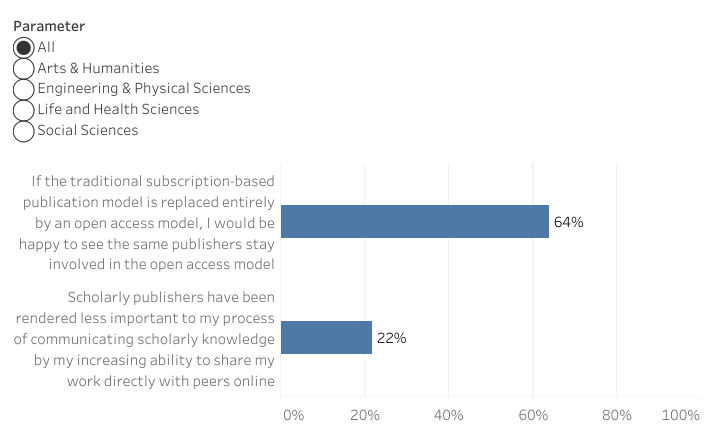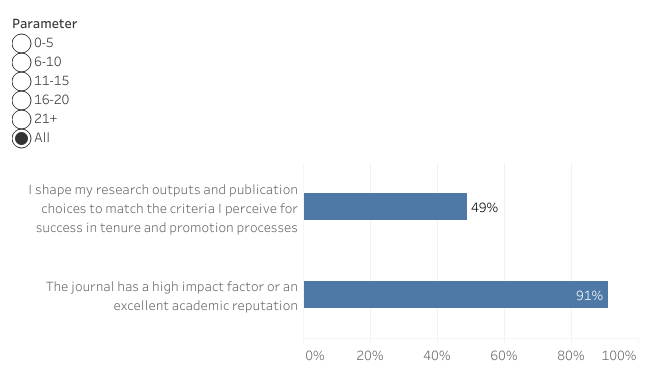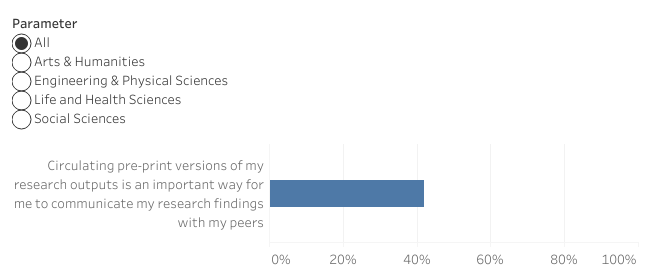Taking the Temperature on Open Access Among UC Berkeley Faculty
In fall 2018, UC Berkeley fielded the Ithaka S+R local faculty survey, concurrent with our national initiative. In this post, Chan Li, Assessment Program Librarian, shares how data from this survey can be used for decision-making in supporting scholarly communication efforts of faculty members. — Christine Wolff-Eisenberg
To promote a publishing ecosystem where the impact of research can be maximized by removing readership barriers, the UC Berkeley Library is making many efforts to push for open access publishing, including signing the OA2020 Expression of Interest and terminating our Elsevier journal subscriptions. But what are our faculty’s opinions on these issues? The Ithaka S+R US Faculty Survey gave us an opportunity to take the temperature of Berkeley faculty’s attitudes on open access.
“I support the open-access initiatives the University has undertaken recently (e.g., the open-access policy, which I’ve used with publishers, and the new initiative to renegotiate our journal contracts).” ― Berkeley faculty survey comment
Do Berkeley faculty support open access? The short answer is yes.
The majority of Berkeley faculty would be happy to see the traditional subscription-based publication model replaced entirely by an open access publication system in which all scholarly research outputs would be freely available to the public. They also strongly agreed that enabling the broadest possible readership of their research outputs is an important way for them to maximize the impact of their research findings. Junior faculty and faculty from life and health sciences departments expressed slightly more enthusiasm about open access.

An interactive version of this chart is available here: https://public.tableau.com/profile/laag#!/vizhome/Ithakablogpost/OASupport
“The prestigious and expensive journals perform an important, if mostly symbolic, task of crystallizing the best research, and their cost and less-than-open access ensures that there is some weight and some serious peer review behind their decisions.” ― Berkeley faculty survey comment
Even though the support to replace the traditional subscription-based publication model is strong, our faculty would still like the same publishers to stay involved in the open access model. Peer review and the highly selective publication process are highly valued by many faculty.

An interactive version of this chart is available here: https://public.tableau.com/profile/laag#!/vizhome/Ithakablogpost/PublisherRole
“Publishing in open access [journals] is not rewarded during the tenure process. Many senior tenured faculty do not understand what open access is and penalize junior faculty for publishing in open access journals, even when these journals have higher impact factors (often the highest impact factors in the corresponding field) than traditional journals.” ― Berkeley faculty survey comment
Publication behavior is still heavily driven by the traditional reward system, and publishing in open access journals is not usually recognized in the tenure and promotion decision-making processes. Half of faculty indicated that they shape their research outputs and publication choices to match the criteria they perceive to be necessary for tenure and promotion. This phenomenon is much more pronounced for junior faculty, who ironically are stronger open access supporters than their tenured peers, according to their attitudinal responses.
The current reward system continues to value the quality of journal publications based on impact factor, a proxy developed in the 1960s for ranking and comparing journals by measuring articles’ average citation frequency in a given period. This metric has been shown to be misleading and misunderstood,[1] especially when journals can have very high impact factors but a majority of their articles are uncited. As restlessness has grown over the flawed criteria to assess scholarly works, a number of initiatives argue that research needs to be assessed on its own value rather than on its publication channels. Despite increasing efforts in the research community, over 90 percent of Berkeley faculty still consider high impact factor an extremely important criterion when determining where to publish.

An interactive version of this chart is available here: https://public.tableau.com/profile/laag#!/vizhome/Ithakablogpost/RewardSystem
“In my field, most scientific preprints are available freely online and paywalls are at most a minor inconvenience that anyone with enough interest can get around.” — Berkeley faculty survey comment
Another finding from the survey is that digital preprint publishing is considered one of the major nontraditional publication channels. The most important value of preprints is that the immediate circulation can allow authors to receive early feedback from the research community, compared with the weeks, months, or even years it can take to publish in peer-reviewed journals.[2]
The survey suggests that the academic practice of sharing through discipline-based or institutional repositories has been very popular among many fields and for many early career faculty. Many faculty indicated that circulating preprint versions of their research outputs is an important way to communicate their research findings with their peers.

An interactive version of this chart is available here: https://public.tableau.com/profile/laag#!/vizhome/Ithakablogpost/preprint
“Journal subscriptions are getting too expensive. I have published in several Elsevier journals for many years. I have heard UC is working to reduce Elsevier’s cost or may leave their system. If they don’t back down, I would leave and we will go even more towards open access. If we do this, more funds will be needed to cover pub costs.” — Berkeley faculty survey comment
Negotiations with Elsevier were still underway during the time the survey was launched, but our faculty were aware of the Library’s efforts to secure open access publishing for research that comes from the University of California and reduce UC’s multimillion-dollar subscription cost with Elsevier. Despite being supportive of open access publishing broadly, many faculty appear to be concerned with the pay-to-publish open access model (e.g., article processing charges).
When asked about the factors that influence faculty’s journal publication channels, a higher percentage of faculty favored journals that permit scholars to publish articles for free rather than journals that make their articles free to read; this is especially the case for departments where fewer faculty receive external government or foundation funding for scholarly research, such as many arts and humanities departments. On the other hand, the majority of faculty from life and health sciences departments, where public funding is more accessible, more heavily favored journals that are free to read.

An interactive version of this chart is available here: https://public.tableau.com/profile/laag#!/vizhome/Ithakablogpost/Cost
Moving Forward
There are still many issues we need to think about in pursuit of open access publishing, such as identifying sustainable funding sources for publication costs and improving the reward system to reflect new criteria to assess scholarly work. However, the overall support for open access is strong among Berkeley faculty, which not only will make the Library’s efforts of partnering with publishers to develop transformative open access agreements worthwhile, but also achievable.
See the full report here.
Notes
[1] Seglen Per O. Why the impact factor of journals should not be used for evaluating research BMJ 1997; 314 :497
[2] Sarabipour S, Debat HJ, Emmott E, Burgess SJ, Schwessinger B, Hensel Z (2019) On the value of preprints: An early career researcher perspective. PLoS Biol 17(2): e3000151. https://doi.org/10.1371/journal.pbio.3000151
Pingbacks
The Tyranny of Unintended Consequences: Richard Poynder on Open Access and the Open Access Movement - The Scholarly Kitchen
Scholarly Communications Digest – Scholarly Communication at Scale